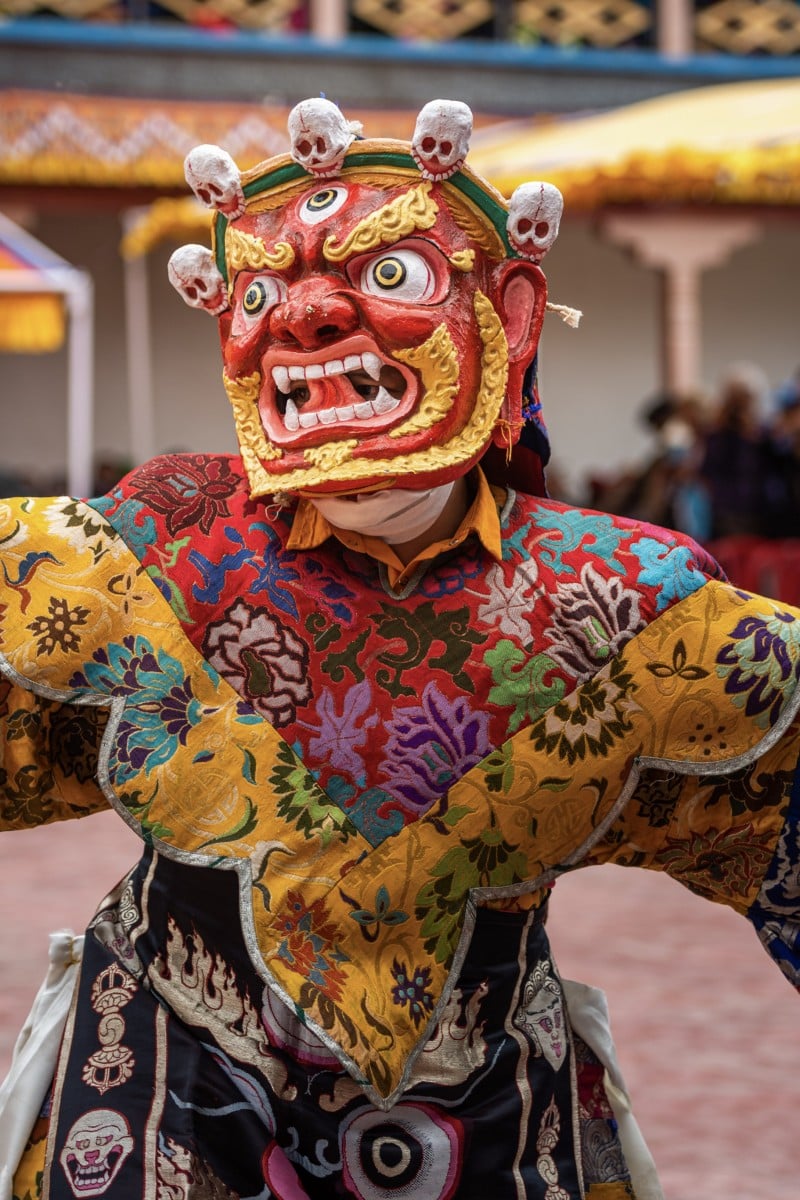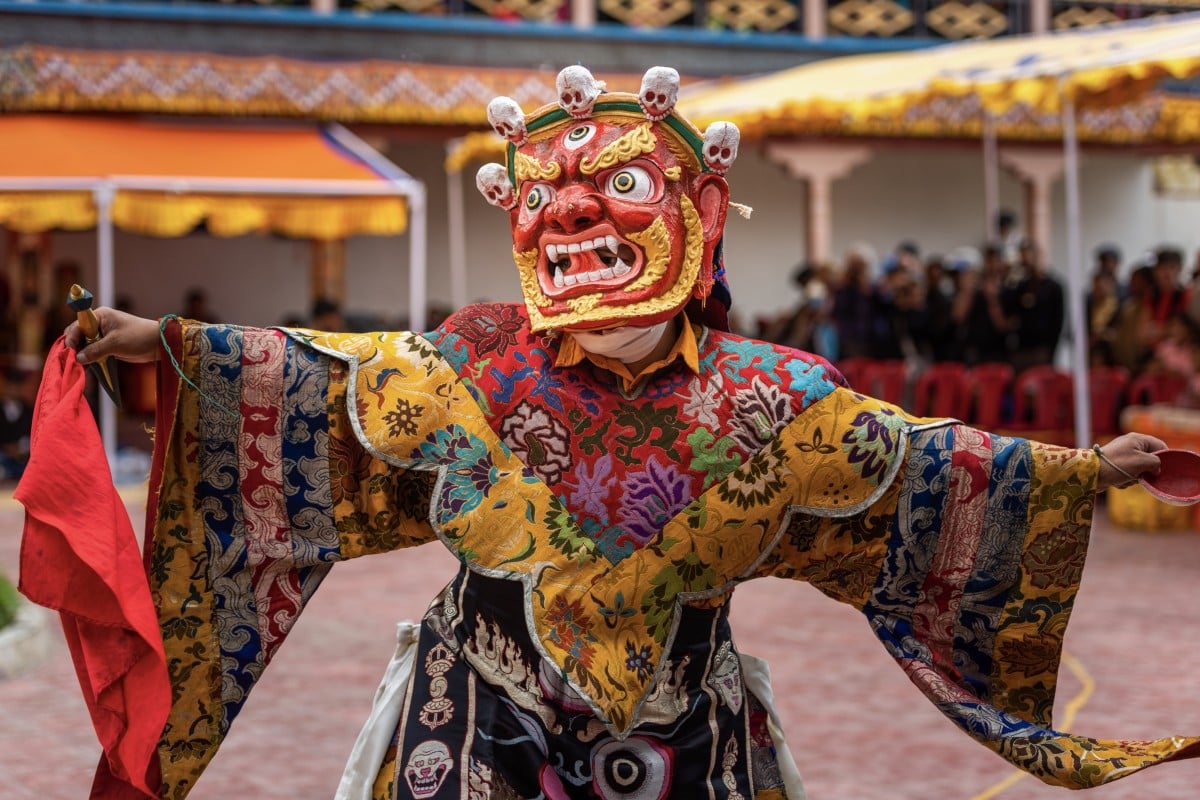
Study Buddy (Challenger): Magic monasteries in Ladakh, India’s Himalayan region where Buddhists dance to defeat evil
This page is for students who want to take their reading comprehension to the next level with difficult vocabulary and questions to test their inference skills.
 A monk wearing a colourful mask and clothes performs a ritual dance at the Takthok festival. Photo: Shutterstock
A monk wearing a colourful mask and clothes performs a ritual dance at the Takthok festival. Photo: ShutterstockContent provided by British Council
Read the following text, and answer questions 1-9 below:
[1] The old man flashes a mischievous, gap-toothed smile, his face furrowed by time like the mountain landscape around him. He radiates contentment as he waves a prayer wheel in his hand. He has been walking since early morning, up and down hills, past rushing torrents, sandy plains, and rocky, snow-covered crests, to which Ladakh, India’s outpost in the Himalayas, owes its beauty.
[2] Hundreds of Ladakhis and tourists from all over the world crowd into the courtyard of the small Takthok cave monastery for a two-day celebration in honour of Padmasambhava. Also known as Guru Rinpoche – precious guru – this Indian scholar is said to have brought tantric Buddhism to the region between the Karakoram and Himalaya mountains.
[3] Located around 50km southeast of the region’s capital, Leh, Takthok is the only monastery in Ladakh that belongs to the oldest school of Tibetan Buddhism with direct links to Padmasambhava. Legend has it that the great magician was born from a lotus flower and got up to all sorts of mischief in his youth. Later, the redeemed scholar vanquished spirits and demons, converted barbarian kingdoms to Buddhism and attained the secret of long life.
[4] Today, Buddhists from Thailand, Cambodia and Bhutan make pilgrimages to the soot-blackened rock cave where Padmasambhava is said to have meditated for years. They prostrate themselves before the small bronze figures depicting the saviour in his various manifestations, incant mantras and feed coins and notes into the cracks in the rock. If the gifts stick, your wishes and dreams are given good chances of coming true.
[5] Monks in colourful silk and brocade robes circle the flagpole in the heart of the monastery complex, their faces covered by wooden masks, many of which are a century old and more. Each meticulously rehearsed dance reverts to Padmasambhava, supposedly revealed to him by Amitabha, the Buddha of all-encompassing love. In the enacted triumph of good over evil, the tantric master may appear as an angry fighter with a skull crown and fangs, or as a gentle apparition with a soft smile.
[6] While not all visitors appreciate the deeper meaning of the legend and dances, it all combines as a unique experience in this more-than-remote location. Ladakh has been officially open to tourists since 1974. The greatest jewel among Ladakh’s monasteries is the Alchi complex. Recognised as a World Heritage site by Unesco, its temples are replete with ornate wood carvings almost 1,000 years old. Figures of the Bodhisattva – those on the path to spiritual awakening – reach several metres to the ceiling, their skirt-like robes bearing small painted vignettes from the life of the Buddha.
[7] Meanwhile, it is getting late in Takthok. After a last dance by the monks, the young and old head to the tents to celebrate. Buses leave every minute for Leh and those who missed a seat must return on foot. The low sun bathes everything in a magical light, including the old man, still swinging his prayer wheel. He will be back tomorrow when the dancing monks again recall the great Padmasambhava, the lotus-born man with psychic powers.
Source: dpa, September 30
Questions
1. Which of the following describes the old man’s mood in paragraph 1?
A. content and peaceful
B. angry and frustrated
C. lost and confused
D. worried and distracted
2. According to paragraph 2, what is the purpose of the celebration at the Takthok cave monastery?
______________________________________________________________________________________________________
3. Based on paragraph 3, why does the writer use the word “redeemed” when describing Padmasambhava’s accomplishments in his adulthood.
______________________________________________________________________________________________________
4. In paragraph 4, what is the belief behind offering coins and notes to the rock cave?
______________________________________________________________________________________________________
5. Find a word in paragraph 4 that refers to the different forms that Padmasambhava is believed to have taken.
__________________________________
6. Who does the “tantric master” in paragraph 5 refer to?
___________________________________________________
7. What is the theme of the dances performed by the monks in paragraph 5?
A. love and compassion
B. the power of nature
C. the struggle between good and evil
D. the beauty of life
8. According to paragraph 6, Ladakh …
A. is a popular destination for those seeking to explore diverse religious practices in a multicultural environment.
B. offers a unique and unforgettable experience for those who appreciate its cultural heritage and historical significance.
C. is a popular destination for adventure seekers, offering opportunities for different sorts of outdoor activities.
D. none of the above
9. In which section of a travel magazine are you most likely to see this article?
A. sustainable travel
B. travel photography
C. off-the-beaten path
D. outdoor adventures
Answers
1. A
2. It is to honour Padmasambhava, the Indian scholar said to have brought tantric Buddhism to the region.
3. To show that Padmasambhava underwent a significant change, leaving behind his youthful mischief and embracing a more spiritual and virtuous path (accept all reasonable answers).
4. It is believed that if the offerings stick to the rock, one’s wishes and dreams have a good chance of coming true.
5. manifestations
6. Padmasambhava
7. C
8. D
9. C
